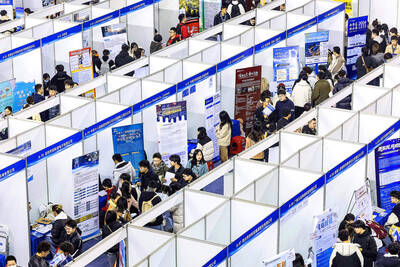The number of employees in the nation held steady in September from one month earlier at 7.95 million, while the average monthly take-home pay rose 2.11 percent year-on-year to NT$42,757, the Directorate-General of Budget, Accounting and Statistics (DGBAS) said yesterday.
The figures suggested a stable workforce, but represented a drop of 67,000 workers from the pre-COVID-19 level, DGBAS Deputy Director Chen Hui-hsin (陳惠欣) told a news conference in Taipei.
“Although Taiwan has kept the virus outbreak at bay, its negative impact lingers,” Chen said.

Photo: Ann Wang, Reuters
The number of employees also shrank 0.47 percent, or by 38,000 people, from the same period last year.
The labor accession rate in September weakened by 0.12 percentage points from August to 2.59 percent, while the labor exit rate softened by 0.1 percentage point to 2.58 percent, the statistics agency said in a report.
That was because the number of people rehired or added to the payroll fell by 9,000 to 206,000, it said.
In the meantime, the number of people who quit, retired or lost jobs dropped by 8,000, it added.
Manufacturing sectors saw the most headcount changes, it said.
The monthly average take-home pay rounded off to NT$42,757 for both domestic and foreign workers, suggesting a 2.11 percent pickup from the level last year, it said.
Adding overtime and performance-based compensations, the total average monthly wage gained 2.41 percent to NT$50,512, it said.
Average working hours totaled 180.9 hours, an increase of 17.7 hours from a year earlier, attributable mainly to more working days this year, the agency said.
Workers at financial and insurance companies registered the biggest increase of 1.47 percent in monthly take-home pay, followed by employees at construction companies with a 1.33 percent raise, the report said.
Staffers at airline companies enjoyed the highest take-home pay of NT$71,232 a month, while those at non-school education facilities had the lowest monthly pay at NT$25,170, it said.
Employees at electronics makers had the highest overall monthly pay of NT$90,082, including bonuses, a 25.58 percent spike from one month earlier, as local suppliers benefited from a boom in business linked to the pandemic.
For the first nine months of the year, average monthly take-home pay increased 1.49 percent year-on-year to NT$42,391, while total monthly compensations edged up 1.74 percent to NT$55,772, the report said.
The Web-based 104 Job Bank (104人力銀行) reported similar findings in an annual survey, saying that the average annual pay would reach NT$641,000 this year, a fractional 0.7 percent increase from last year.
Only 2.9 percent of local companies raised monthly wages for employees this year as most of them have adopted a conservative business outlook amid the pandemic, the job bank said.

Stephen Garrett, a 27-year-old graduate student, always thought he would study in China, but first the country’s restrictive COVID-19 policies made it nearly impossible and now he has other concerns. The cost is one deterrent, but Garrett is more worried about restrictions on academic freedom and the personal risk of being stranded in China. He is not alone. Only about 700 American students are studying at Chinese universities, down from a peak of nearly 25,000 a decade ago, while there are nearly 300,000 Chinese students at US schools. Some young Americans are discouraged from investing their time in China by what they see

MAJOR DROP: CEO Tim Cook, who is visiting Hanoi, pledged the firm was committed to Vietnam after its smartphone shipments declined 9.6% annually in the first quarter Apple Inc yesterday said it would increase spending on suppliers in Vietnam, a key production hub, as CEO Tim Cook arrived in the country for a two-day visit. The iPhone maker announced the news in a statement on its Web site, but gave no details of how much it would spend or where the money would go. Cook is expected to meet programmers, content creators and students during his visit, online newspaper VnExpress reported. The visit comes as US President Joe Biden’s administration seeks to ramp up Vietnam’s role in the global tech supply chain to reduce the US’ dependence on China. Images on

Taiwan Transport and Storage Corp (TTS, 台灣通運倉儲) yesterday unveiled its first electric tractor unit — manufactured by Volvo Trucks — in a ceremony in Taipei, and said the unit would soon be used to transport cement produced by Taiwan Cement Corp (TCC, 台灣水泥). Both TTS and TCC belong to TCC International Holdings Ltd (台泥國際集團). With the electric tractor unit, the Taipei-based cement firm would become the first in Taiwan to use electric vehicles to transport construction materials. TTS chairman Koo Kung-yi (辜公怡), Volvo Trucks vice president of sales and marketing Johan Selven, TCC president Roman Cheng (程耀輝) and Taikoo Motors Group

New apartments in Taiwan’s major cities are getting smaller, while old apartments are increasingly occupied by older people, many of whom live alone, government data showed. The phenomenon has to do with sharpening unaffordable property prices and an aging population, property brokers said. Apartments with one bedroom that are two years old or older have gained a noticeable presence in the nation’s six special municipalities as well as Hsinchu county and city in the past five years, Evertrust Rehouse Co (永慶房產集團) found, citing data from the government’s real-price transaction platform. In Taipei, apartments with one bedroom accounted for 19 percent of deals last